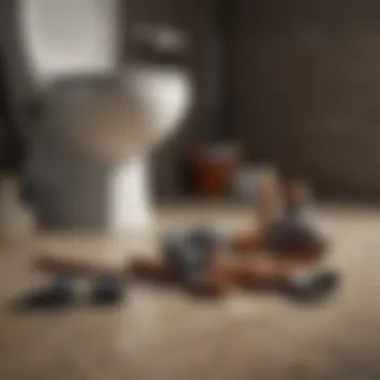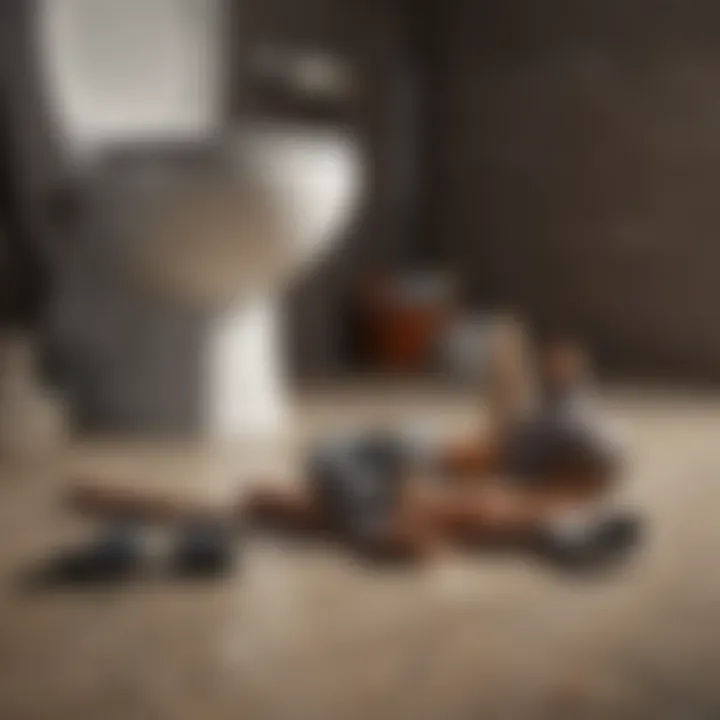Unstopping a Toilet: A Practical Guide


Intro
Dealing with a clogged toilet can be an inconvenient and unpleasant experience for any homeowner. Understanding how to properly address this issue is essential for maintaining a functional and hygienic bathroom. This guide aims to provide clear and practical steps to effectively unclog a toilet, explore common blockage causes, and outline necessary tools and preventative maintenance strategies.
With proper knowledge, you can avoid mishaps and keep your sanitation system running smoothly. Not only will this guide assist you in addressing current obstructions, but it will also help you to avert future problems that may compromise your overall plumbing system.
Common Causes of Toilet Blockages
To resolve a blockage, one must first identify its source. There are several common culprits that can cause toilets to clog. Some of these include:
- Excessive toilet paper use
- Flushing non-flushable items
- Clogs due to foreign objects
- Mineral deposits within the pipes
- Sudden changes in pressure
Understanding these causes enables you to approach the problem with appropriate methods and tools.
Necessary Tools for Unclogging
When faced with a clogged toilet, having the right tools can make a significant difference. Here are some essential items you may need:
- Plunger: A basic yet effective tool for most clogs. Choose a flange type for better suction.
- Toilet Auger: Also known as a toilet snake, it can reach deeper blockages that a plunger cannot.
- Rubber Gloves: To maintain hygiene while handling potential waste.
- Bucket: Useful for containing any overflow during the process.
- Baking Soda and Vinegar: A natural solution for minor clogs.
Techniques for Unclogging a Toilet
Using a Plunger
- Begin by ensuring there's enough water in the toilet bowl to cover the plunger's bell.
- Position the plunger directly over the drain hole. Press down gently to create a seal.
- Pump the plunger up and down vigorously for 15 to 20 seconds.
- Flush the toilet to see if the blockage has cleared.
Using a Toilet Auger
- Insert the auger into the toilet bowl and feed it into the drain.
- Turn the handle clockwise to break up or retrieve the obstruction.
- Pull the auger out slowly, disposing of any debris.
- Flush to confirm that the clog is resolved.
Chemical Solutions
If the above methods don’t work, consider using a store-bought clog remover. However, follow the instructions carefully, as these products can be harsh on plumbing.
Maintenance Tips
Preventative care is the key to avoiding future clogs. Here are a few maintenance strategies:
- Educate Family Members: Make sure everyone is aware of what can and cannot be flushed down the toilet.
- Regular Cleaning: Regularly clean your toilets and remove mineral deposits.
- Check the Water Level: Ensure that the water levels in the toilet tank are correct to facilitate efficient flushing.
Culmination
Unstopping a toilet necessitates a systematic approach. The effective methods and tools discussed here can empower you to tackle blockages with confidence. Furthermore, understanding the underlying causes and adopting proactive maintenance practices can help prevent issues down the line. Incorporating these strategies will not only improve your plumbing's efficiency but also enhance your overall household hygiene.
Understanding Toilet Mechanisms
Understanding toilet mechanisms is a fundamental aspect of addressing issues related to toilet clogs. Awareness of the various components and how they work together not only aids in effective unclogging but also enhances general toilet maintenance and longevity. Homeowners, in particular, can benefit from this knowledge as it empowers them to diagnose problems accurately before seeking professional assistance. Knowing how each part interacts contributes to effectively managing the toilet system as a whole.
Basic Components of a Toilet
Toilet bowl
The toilet bowl is perhaps the most recognized element of the toilet. It is designed to hold water and waste, forming the first stage of the flushing system. The key characteristic of the toilet bowl is its shape and depth, which are critical for effective waste removal. A standard toilet bowl allows for minimal splashing while ensuring sufficient water is present to aid in the flushing process. One unique feature is the siphon design, which uses gravity and water flow to facilitate removal of waste. However, a common disadvantage is if the bowl is not filled to the proper water level, it may lead to incomplete flushes.
Tank
The tank sits atop the toilet bowl and serves a crucial role in the flushing mechanism. It holds the water needed for flushing and contains the necessary components for initiating a flush. A notable characteristic of the tank is its ability to refill after a flush, which is essential for continuous use. The flush valve within the tank is a unique feature that directly controls the release of water into the toilet bowl. However, if the tank does not function properly or leaks, it can lead to water waste and ineffective flushing.
Flush mechanism
The flush mechanism acts as the heart of the toilet system. It represents how effectively waste is removed when the toilet is flushed. This mechanism often includes levers, flappers, and chains that engage during the flush process. One key characteristic here is the simplicity of operation; pulling the lever allows users to initiate flushing with ease. However, the unique feature of this mechanism is its sensitivity to wear and tear. Mechanical failure can block flushing or cause more extensive plumbing issues. Understanding the intricacies of the flush mechanism is vital for troubleshooting persistent toilet problems.
How a Toilet Functions


The flushing process
The flushing process is where the entire system comes into play. When the user pulls the lever, the flush mechanism engages, allowing water from the tank to rush into the bowl. This action is paramount for waste removal. The rapid influx of water generates force, pushing the waste down into the drainage system. A crucial aspect of this process is the timing; a proper flush needs to ensue quickly to ensure effective waste removal. However, if not executed correctly, it can result in frequent clogs.
The siphon effect
The siphon effect is an essential principle that helps in the effective flushing of toilets. Once the tank empties into the bowl, the curved shape of the toilet bowl creates a siphon where the pressure difference helps pull the waste out. This design is advantageous as it reduces the water needed for effective flushes and diminishes the risk of clogs after the flush. However, should there be air leaks or if the siphon fails, the flush result may be significantly compromised.
Importance of water levels
Water levels in both the bowl and tank are critical to the toilet's operation. The right water level in the tank is necessary to provide the proper force during flushes; if this level is too low, flushing may not be effective. In the bowl, water levels also play a crucial role in maintaining hygiene; too low levels can result in odors and inadequate waste flushing. Monitoring and adjusting these levels ensures that the toilet functions optimally. However, fluctuating water levels may require further attention to the plumbing setup.
Identifying a Stopped Toilet
Grasping the signs that indicate a stopped toilet is an essential first step in managing potential plumbing issues. Recognizing these early signals can prevent further complications, saving both time and money. When homeowners can identify these signs, it leads to more informed decisions for maintenance and repairs. Prompt action minimizes inconveniences in daily life, ensuring a more sanitary and functioning bathroom environment.
Common Signs of Clogging
Slow drainage
Slow drainage is often the initial symptom of a clogged toilet. This specific aspect signifies that water is not flowing as freely as it should. Homeowners need to pay attention to how quickly the toilet bowl empties after a flush. Slow drainage is an early warning that can help allert the homeowner to underlying issues. The key characteristic with this condition is its ability to build up over time. If left unchecked, it will likely escalate into major problems. In terms of its benefits for the article, recognizing slow drainage encourages proactive measures to prevent clogs.
Backed up water
Backed up water is a more alarming sign that should not be ignored. It indicates a severe blockage, which can lead to overflows and messy clean-ups. Homeowners must recognize that water levels rising in the bowl usually suggest a backup in the drainage system. This characteristic is crucial as it serves as a definitive signal of problems within the plumbing. Identifying this issue promptly is critical, since it can not only create a sanitary hazard but also damage surrounding areas. The unique feature of backed-up water is its potential to overflow, making it a serious concern in any household.
Frequent need for plunging
The frequent need for plunging is another disturbing sign that indicates trouble within the toilet system. If a toilet requires repeated attempts to unclog, it suggests ongoing clogs. This characteristic implies that there might be something more persistent obstructing proper flow. It's a common issue many face, marking it as a vital point of discussion in this article. The unique feature is its consistency; if plunging is necessary often, it indicates a need for further investigation. Understanding this can help homeowners to take preventive actions before facing severe plumbing issues.
Causes of Toilet Clogs
Identifying the underlying causes of toilet clogs is essential for effective management and prevention. By understanding these causes, one can adopt better habits and choose proper maintenance routines.
Excess toilet paper
Excess toilet paper is a prevalent cause of toilet clogs. When too much paper is flushed at once, it can easily lead to a blockage. This specific aspect contributes significantly to the overall problem of clogs, revealing a common challenge for many homeowners. The key characteristic of excess toilet paper is its ability to expand when wet, creating a mass that can obstruct pipes. Highlighting this condition in the article helps readers understand necessary precautions when using toilet paper.
Foreign objects
The term foreign objects encapsulates a variety of items that shouldn’t be in a toilet. This includes anything from feminine hygiene products to toys. Understanding this aspect of clogs allows homeowners to grasp the range of potential issues that may arise. The key characteristic of such clogs is the unexpected nature of the object blocking the flow. When identifying this topic, it brings to light the importance of proper disposal practices. Knowing how these blockages can occur helps create awareness about keeping toilets clear of non-flushable items.
Mineral build-up
Mineral build-up can happen over time, especially in hard water areas. This specific aspect pertains to the accumulation of minerals that can create scale within pipes. Understanding mineral build-up is important as it contributes to gradual clogs and reduced efficiency. Its key characteristic is that it does not become apparent immediately, allowing it to escalate unnoticed. By mentioning this in the article, readers are made aware of how regular maintenance can help mitigate these issues.
Essential Tools for Unclogging
Understanding the right tools for unclogging toilets is essential for effective plumbing maintenance. Proper tools can make the difference between a simple fix and a more complex problem. Having the right tools helps to address clogs quickly and safely. In this section, we will explore various tools that can aid in unclogging a toilet.
Types of Plungers
Standard cup plunger
The standard cup plunger is the most common type of plunger used in households. Its shape, which resembles a cup, provides a basic yet effective mechanism for removing blockages. The key characteristic of the standard cup plunger is its ability to create strong suction. This feature makes it a popular choice for homeowners facing simple clogs.
One unique feature of this plunger is its straightforward design, which makes it easy for anyone to use. However, the limitations of the standard cup plunger arise when dealing with deeper or more stubborn clogs. It may not reach obstructions that are further down the toilet drain.
Flange plunger
The flange plunger takes the classic design a step further. It includes an additional flap or flange that extends from the rubber cup. This design enhances its ability to seal the toilet bowl, resulting in more effective suction and pressure. This tool is particularly beneficial for toilets because it fits better into the toilet drain, providing a snug seal.
With its unique feature allowing for a better grip against the toilet's drain, the flange plunger can handle tougher clogs that the standard cup plunger may struggle with. However, it requires the user to have some familiarity with its use to be fully effective.


Alternative Tools
Toilet auger
When plungers are not sufficient, a toilet auger can be an invaluable tool. This device features a long, flexible metal cable with a handle at one end. The most notable aspect of the toilet auger is its ability to reach clogs further down in the plumbing system. It is a beneficial option for more serious blockages.
The unique rotating head of the auger can break up or snag foreign objects causing the blockage. This means it can handle issues that a plunger cannot. However, it does require a bit more skill to use effectively, as improper use can damage the toilet or plumbing.
Drain snakes
Drain snakes are designed for multiple applications, including toilets. A key feature of drain snakes is their long, flexible, coiled wire that can navigate bends in pipes. This makes them ideal for accessing deeper clogs that are not reachable by plungers or augers.
The advantage of the drain snake lies in its versatility. It can be used to clear various types of blockages, making it a valuable addition to any homeowner's plumbing toolkit. However, it can also be tricky to use for those who are not familiar with its operation, requiring practice and care.
Step-by-Step Unclogging Process
In this section, we explore the step-by-step methods crucial for efficiently unclogging a toilet. Following these procedures can help homeowners regain functionality in their bathrooms while minimizing potential mess and damage. Each step in the process is significant, as understanding the nuances can lead to quicker and more effective resolutions to toilet blockages. This clarity can transform a frustrating situation into a manageable task.
Preparation of the Area
Protective gear
Wearing protective gear is essential when addressing a clogged toilet. Such gear usually includes gloves and goggles, which serve to protect the skin and eyes from contact with toilet water and potential contaminants. The most important aspect of protective gear is its ability to provide a barrier against bacteria and harmful substances present in waste. For those who may not be familiar, it is a beneficial choice for ensuring safety during the unclogging process. Its unique feature lies in the combination of comfort and protectiveness, allowing users to tackle the task without hesitation. While disposable gloves are very popular for cleaning, they may create discomfort if worn for long periods, stressing the importance of finding a balance that works for you.
Cleaning up spills
Cleaning up spills immediately after a blockage is crucial in maintaining a hygienic bathroom environment. Failing to do so can lead to further complications, such as lingering odors and bacteria growth. The key characteristic of cleaning up spills is efficiency. Utilizing absorbent materials, like towels or mops, can prevent the spread of water and waste, making it a practical choice within this guide. A unique benefit is the ability to protect flooring and fixtures from water damage while addressing aesthetic concerns. However, not acting quickly can turn a small issue into a larger mess, underscoring the need for immediate attention.
Using a Plunger Effectively
Correct technique
Employing the correct technique when using a plunger is vital for ensuring successful unclogging. The essence of this aspect lies in the ability to create sufficient pressure and suction to dislodge the obstruction. A well-known method involves forming a tight seal around the drain and pushing down with controlled force before pulling up sharply. Utilizing the right technique is a popular and effective measure in this context. Its unique feature is that it demands a certain level of skill and practice, allowing for varied effectiveness depending on the user.
Timing and pressure
Understanding timing and pressure can greatly influence the effectiveness of using a plunger. The relationship between these two factors matters, as applying pressure at the right moment can enhance the overall outcome. In this discussion, timing refers to the rhythm of your plunging, while pressure applies to how forcefully the plunger is applied. Recognizing the importance of both elements can significantly improve the unclogging process. It is a beneficial insight for readers, emphasizing that this delicate balance is necessary for success. However, improper timing can lead to wasted effort or frustration.
When to Use an Auger
Identifying stubborn clogs
Stubborn clogs can resist even the most determined efforts with a plunger. Identifying these clogs early can save time and effort. A key characteristic of stubborn clogs is their resistance, often due to solid or densely packed materials. Recognizing when normal methods fail makes this an important aspect in the unfolding process of unclogging. The ability to accurately identify these clogs contributes to making wise decisions about which tools to employ. An advantage is that understanding when to reach for an auger can significantly cut down on frustration.
Technique for use
Using an auger requires a specific technique to ensure effectiveness. This tool, also known as a toilet snake, can navigate tough obstructions without damaging the toilet. The best practice for using it involves gently inserting the auger into the drain until encountering resistance, at which point users should rotate the handle to break through the blockage. Familiarity with this technique is beneficial since improper use may cause further issues down the line. Those lessons on technique can vastly enhance the experience when confronting persistent clogs in a toilet.
Post-Unclogging Maintenance
After successfully unclogging a toilet, many homeowners may overlook the importance of proper upkeep. Post-clog maintenance is crucial in ensuring that toilets function optimally over time. Neglecting routine care can lead to future blockages or even more serious plumbing issues. The benefits of maintaining a clean and functional toilet extend beyond mere convenience; they impact hygiene and the lifespan of plumbing systems.
Routine Cleaning Practices
Choosing the right cleaners
Selecting appropriate cleaning products is vital for both hygiene and toilet longevity. Many traditional toilet cleaners leave residue or can be harmful to pipes over time. A key characteristic of effective toilet cleaners is their ability to disinfect while minimizing harm to plumbing. Eco-friendly options, like vinegar and baking soda, are becoming increasingly popular. They are gentle on fixtures and can effectively dissolve buildup without introducing toxic chemicals into the waste system. Their advantage includes non-corrosive properties, but they may not always be as strong as commercial cleaners for tough stains.
Frequency of cleaning
The frequency of cleaning a toilet directly affects its performance. For many households, cleaning every week is a beneficial practice. Regular cleaning prevents the accumulation of grime and mineral deposits, which can lead to clogs. This proactive approach helps in identifying small issues before they escalate into significant problems. However, some may find weekly cleaning challenging due to scheduling. In such cases, at least bimonthly cleaning should be made a priority to retain toilet function.
Preventive Measures to Avoid Future Clogs


Preventive strategies are as important as post-maintenance. Being diligent about waste disposal and education can mitigate clogging risks significantly.
Proper disposal of waste
Educating the household on proper disposal methods allows users to significantly reduce the chances of clogs. Only human waste and toilet paper should be flushed. Items like wipes or feminine products must be disposed of in the trash, despite packaging claims that suggest they are flushable. The uniqueness of this practice lies in its sustainable approach, where every member of the household understands the stakes. The advantage is clear – fewer blockages result in less frequent plumbing interventions.
Education on toilet usage
Creating awareness about proper toilet usage can save considerable trouble down the line. Educating everyone on what can and cannot be flushed ensures that toilets remain in good condition. This knowledge empowers users, making them more responsible and attentive. An added bonus includes cultivating a culture of care for home plumbing systems. However, despite its benefits, some may forget or disregard guidelines, making consistent reminders necessary to reinforce these lessons.
"Understanding proper care and maintenance is essential for any plumbing system to work effectively."
By considering these practices and preventive measures, homeowners not only maintain toilet function but also contribute to a more efficient plumbing environment. Incorporating these strategies is pivotal for long-lasting sanitation solutions.
Troubleshooting Persistent Issues
Troubleshooting persistent issues with a toilet can save homeowners significant time and expense. Understanding the underlying problems is crucial for effective solutions. This section focuses on recognizing plumbing issues that may lead to frequent clogs. Identifying these issues ensures that further damage to the plumbing system is avoided and that the toilet functions optimally.
Identifying Underlying Plumbing Problems
Drain line obstructions
Drain line obstructions can severely inhibit the flow of waste and water, causing ongoing problems within the toilet system. A common characteristic of such obstructions is the gradual buildup of debris in the pipes, which often goes unnoticed until significant clogging occurs. This aspect is vital for the reader because awareness of how drain line obstructions form can empower them to take preventive measures.
Key features of drain line obstructions include their potential to stem from excessive toilet paper usage or the flushing of foreign objects. These factors contribute to either a complete blockage or slow drainage, which can be discouraging for users. In this article, recognizing the signs of these obstructions helps readers to promptly address common issues rather than wait for them to escalate.
The benefits of identifying drain line obstructions early include not only preventing major clogs but also facilitating timely maintenance. However, ignoring these signs may lead to worse problems, requiring expert plumbing interventions.
Ventilation issues
Ventilation issues can heavily impact the performance of a toilet. If the plumbing system fails to properly vent, sewage gases can build up, causing odors and inefficient drainage. A key characteristic of ventilation problems is that they often manifest as multiple plumbing fixtures showing reduced performance, not just the toilet. This makes it essential for homeowners to recognize these symptoms across their plumbing fixtures.
The unique feature of ventilation issues is that they may arise from either structural changes to the home or obstructions in the vent pipes. Addressing these issues is beneficial, as a well-ventilated system ensures that waste disposes of efficiently, helping to maintain a clean and odor-free environment. Ignoring this can lead to severe drainage problems and costly repairs.
When to Seek Professional Help
Homeowners should consider professional assistance in specific situations, especially when tackling persistent toilet issues. Recognizing when to seek help not only mitigates frustration but also protects the investment in plumbing systems.
Indicators of serious blockage
Indicators of serious blockage can be harder to detect initially but are critical for any plumbing issue. Common signs include multiple fixtures becoming clogged simultaneously or the toilet failing to flush after multiple attempts. These indicators show that the problem may extend beyond a simple clog. Spotting these signs allows readers to appreciate the gravity of persistent issues early.
Understanding these indicators promotes timely action. Delaying repairs could result in more significant plumbing disasters or extensive damage, leading to higher repair bills.
Choosing a reliable plumber
Choosing a reliable plumber is essential for resolving serious plumbing issues effectively. Homeowners should consider factors such as the plumber's experience, references, and whether they have the necessary licenses. A dependable plumber can assess and resolve underlying problems that homeowners may not recognize.
Key to this selection process is understanding the unique features of local plumbing services, including their responses to emergencies and warranties on their work. An experienced plumbing professional can drastically reduce the risks associated with plumbing issues. Investing time in choosing a reliable plumber can save money and contribute to the long-term health of the plumbing system.
Sustainability Considerations
The focus on sustainability in modern plumbing practices is essential for promoting responsible water usage. As individuals become more aware of their environmental impact, the demand for eco-friendly solutions has grown significantly. This section explores the intersection of plumbing and sustainability, shedding light on how homeowners can make choices that conserve water and reduce their ecological footprint.
Impact of Plumbing on Water Conservation
Efficient toilet designs
Efficient toilet designs represent a significant step toward water conservation. These designs utilize less water per flush while maintaining effective waste removal. A key characteristic of efficient toilets is their dual-flush systems, which allow users to select the amount of water needed based on the waste type. This feature is beneficial as it minimizes water usage, often cutting down consumption by 30% or more.
However, the unique feature of some efficient toilets is their reliance on gravity rather than pressure assist. This can lead to a quieter operation and lessen the need for complex repair mechanisms. Overall, efficient toilet designs offer the advantage of sustainability without compromising functionality, making them a wise investment for homeowners aiming to reduce their water usage.
Reducing water waste
Reducing water waste is another critical aspect of plumbing sustainability. Simple adjustments, such as installing low-flow fixtures, can lead to significant water savings. The popularity of these systems is largely due to their efficiency; they can cut water usage by up to 50% compared to standard fixtures.
An essential element of reducing water waste includes the implementation of smart toilet technology. These toilets can sense when to flush and can adjust the water flow based on individual needs. While the upfront cost of smart toilets may be higher, the long-term savings on water bills and the positive environmental impact are notable advantages.
Eco-Friendly Maintenance Solutions
Natural clog removers
Natural clog removers are an appealing option for many homeowners. These solutions are often made from common household items, such as baking soda and vinegar, which can clear minor clogs effectively. A notable characteristic of natural clog removers is that they contain no chemicals, making them safer for both plumbing systems and the environment.
The unique feature of these removers is their dual-action process: the baking soda provides an abrasive quality, while the vinegar's acidity helps disintegrate waste. One of the disadvantages is that they may not be as effective on severe clogs, but regular use can help maintain clear drains.
Benefits of environmentally safe products
The benefits of environmentally safe products extend beyond just plumbing. These products minimize negative effects on ecosystems while ensuring the health of indoor air quality. A key characteristic of these products is that they avoid harsh chemicals, reducing the risk of pollution in both drains and waterways.
Their unique feature often includes biodegradable ingredients, which break down naturally in the environment. While some may argue that these products can be pricier than traditional options, the peace of mind of using safer materials aligns with long-term sustainability goals. Moreover, the use of eco-friendly products can foster a culture of awareness and responsibility among homeowners, encouraging more sustainable lifestyle choices.







